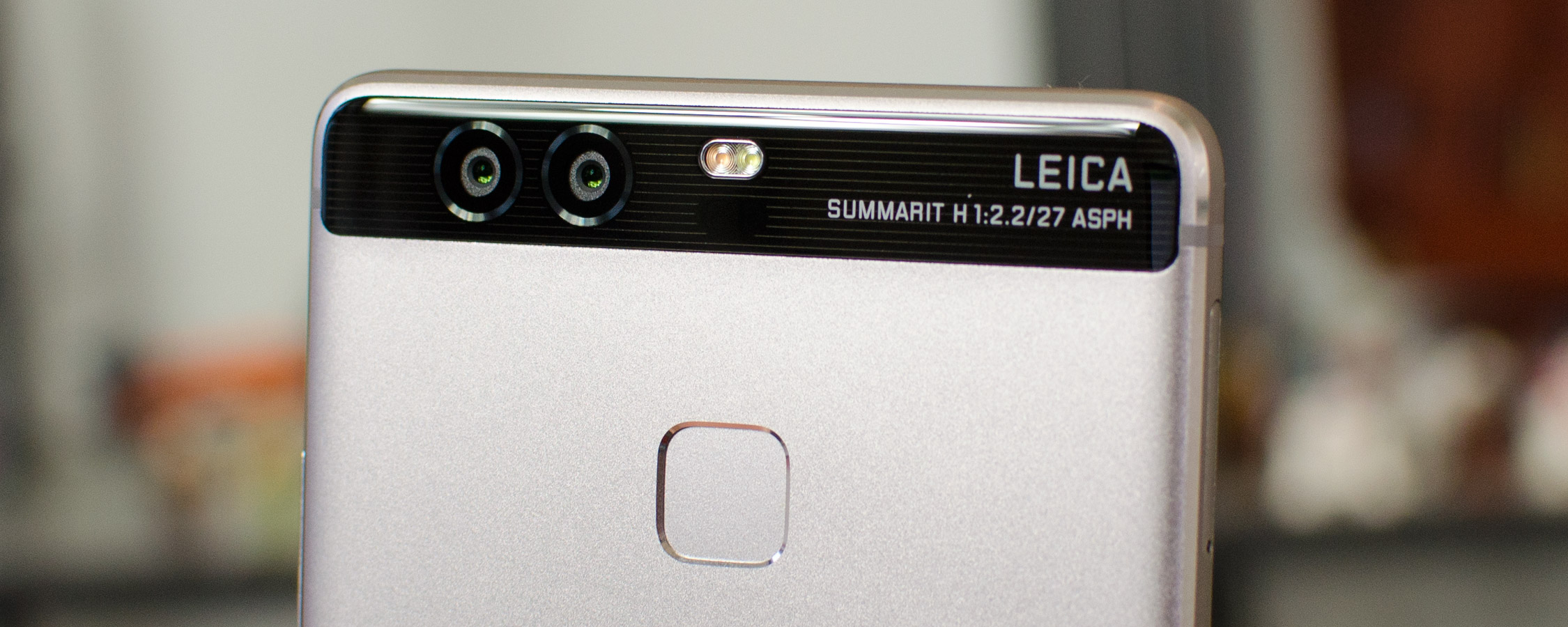Camera Quality: Dual Leica Lenses
The Huawei P9's camera setup could be this device's most interesting feature. Instead of opting for a standard single-camera solution, Huawei has chosen to use two camera sensors side by side. One of these cameras provides the full RGB color spectrum, while the other is monochrome. Combined, the two sensors produce sharper images, improve low light performance, and allow interesting software features like re-focusing and simulated variable aperture.
The two cameras appear to be identical. Both are 11.8-megapixel (3968 x 2976) Sony IMX286 1/2.8" CMOS sensors with 1.25 µm pixels, paired with f/2.2 27mm (equivalent) lenses. As the monochrome sensor has fewer filters, it can capture twice the light data as the RGB sensor. When the two sensors are paired together, this camera can achieve three times the light gathering capabilities of a single sensor unit, which greatly offsets the less light-friendly hardware like the f/2.2 lens and lack of optical image stabilization.
The camera is Leica certified to pass the imaging company's standards, although the lenses themselves aren't actually produced Leica. On the rear is both a two-tone LED and a well-hidden laser autofocus system. Unfortunately, due to SoC restrictions, the P9 can't capture 4K video, which is a big disappointment here. Both the front and back cameras are restricted to just 1080p capture. Speaking of the front camera, it's an 8.0-megapixel (3264 x 2448) Sony IMX179 1/3.2" CMOS sensor with 1.4 µm pixels, paired with an f/2.4 26mm (equivalent) lens.
I was reasonably happy with the level of detail present in images from 12-megapixel stills. This resolution is the new standard for most flagship smartphone cameras, with companies opting for larger pixels than pure megapixel counts. The one exception here is the LG G5, although LG's use of very heavy noise reduction filters leads to less detail present in its 16-megapixel stills than the Huawei P9. You'll also see less detail from the Galaxy S7 Edge, with the HTC 10 being a clear winner in this regard.
There is only a slight lack of definition present when viewing photos from the Huawei P9 at full resolution. Downscaling them to a smartphone display delivers largely the same experience as its competitors.
Dynamic range from the P9's camera is outstanding, even without the HDR mode. Often smartphone cameras will reduce color depth or contrast in areas with bright highlights or dark shadows, but the P9 manages to retain these qualities while providing good detail and visibility. The HDR mode improves this further but is only suitable in high-contrast environments, as it can produce an over processed look in standard scenes.
Photos produced by the Huawei P9 have great color quality, slightly better than the HTC 10, but slightly inferior to the Galaxy S7 and LG G5. Like most phone cameras, the Huawei P9 is excellent in strong lighting conditions, but noticeably less good indoors and under artificial lights. The LG G5 and, in particular, the Galaxy S7 have a clear edge here, as the P9 has a habit of either producing fantastic or substandard photos in these conditions; it's a bit hit or miss.
The standard shot on the left is fantastic, but it's even better after simulated f/2.8 DSLR lens effects are applied (right)
However, if you do capture a decent image using the Huawei P9, the ability to add in artificial bokeh can improve the quality of your shot by fair amount, which can give photos an edge over those taken with the Galaxy S7 or G5. These two aforementioned phones use wider aperture lenses, and so get better bokeh straight off the sensor, but the P9's dual camera system can take things to the next level.
The Huawei P9's low light performance is average. The ISO and shutter speed limits of 3200 and 1/17s in the auto mode hamper the ability to take strong photos in very dark scenes without the flash. The LG G5 and Galaxy S7 are both superior here, leaving the Huawei P9 with similar performance to the HTC 10 in terms of brightness and color quality.
There are a few things going in the P9's favor in low light, though. Unless I was deliberately attempting to shake the camera, I basically never captured a blurry image, despite a lack of OIS. Detail and accurate colors seem to be preserved quite well here, even if that introduces a bit of grain to the photo. In situations that aren't as dark, the Huawei P9 deals really well with blacks and greys, resisting the urge to under or overexpose in poor conditions.
I was pleased but not blown away by the quality of the 8-megapixel selfie camera. It produces acceptable photos in most lighting situations, only struggling when it gets really dark. The level of detail is perhaps this camera's strong suit, with color quality a step behind the rear cameras in general.














